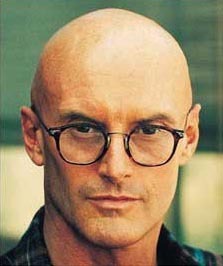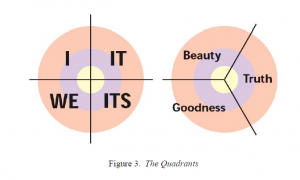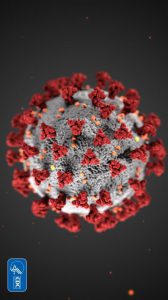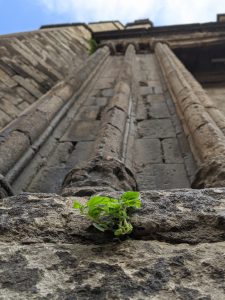
There are many overlapping concepts when I think about Pedagogical Practice and Curricular Design (this section). They both have many moving parts and many of the lessons and patterns evidence in the 3 Sisters Garden also emerge in Curricular Design. The biggest difference in my mind is that Curricular Design is about development of yourself as a teacher and development of your knowledge and organization of the content from your discipline. For that reason, this section will focus on some of the systems I use to keep myself from becoming stagnant and complacent in my teaching. I had a conversation with my first principal where she asked me what the difference was between a good and great teacher. I ventured a guess that good teachers engage most of their class, but great teachers engage them all. She agreed that engagement was a key, but said that she didn’t think it was realistic, especially for a beginning teacher, to expect to engage 100% of their students 100% of the time. She said that in her experience both good and great teachers can consistently engage about 70-80% of their students on any given day. The difference, she said is that for the good teachers it’s always the same kids, but for the great teachers is a different group of kids each day. That conversation has really helped me over the years. It removed the unrealistic pressure of always having every kids engaged, but also added a realistic path to increasing the chances that every student will gain something from my class.
 Since then I have been working to develop systems, skills and tools to increase the engagement of my students in a way that can provide some structure and consistency, while also providing variety and interest to all students in the class. One of the most helpful tools I have found came from the American writer and philosopher Ken Wilber. I first discovered him on a trip to the infamous Powell’s bookstore in Portland. While perusing the shelves I found a book entitled, “A Theory of Everything“, I was intrigued, but skeptical. I picked up the book expecting to look at the table of contents and return the book having confirmed the authors failure to achieve success as such a bold endeavor, but instead I found the book really did have almost everything in it. My planned 30 second glance become 20 minutes of reading excerpts in the aisle and to be honest still continues to this day. It took me 6 months to get through that first book, not because I forgot about it, but because I found the ideas and concepts so rich and engaging that after reading a page or two I could spend an 10 minutes or more just thinking about the unseen connections and unresolved patterns from my own experience that Wilber’s theory helped to fall into place. There are many things in Wilber’s books that I disagree with many of which are addressed here and here, but I still find his basic structure to be very helpful in thinking about my own development, the understanding of my discipline, and as a way to increase the engagement of my students.
Since then I have been working to develop systems, skills and tools to increase the engagement of my students in a way that can provide some structure and consistency, while also providing variety and interest to all students in the class. One of the most helpful tools I have found came from the American writer and philosopher Ken Wilber. I first discovered him on a trip to the infamous Powell’s bookstore in Portland. While perusing the shelves I found a book entitled, “A Theory of Everything“, I was intrigued, but skeptical. I picked up the book expecting to look at the table of contents and return the book having confirmed the authors failure to achieve success as such a bold endeavor, but instead I found the book really did have almost everything in it. My planned 30 second glance become 20 minutes of reading excerpts in the aisle and to be honest still continues to this day. It took me 6 months to get through that first book, not because I forgot about it, but because I found the ideas and concepts so rich and engaging that after reading a page or two I could spend an 10 minutes or more just thinking about the unseen connections and unresolved patterns from my own experience that Wilber’s theory helped to fall into place. There are many things in Wilber’s books that I disagree with many of which are addressed here and here, but I still find his basic structure to be very helpful in thinking about my own development, the understanding of my discipline, and as a way to increase the engagement of my students.

According to the Wiley Online Library, “Integral theory is a way of knowing that helps foster the recognition that disparate aspects of reality—such as biological constitution, cultural world‐views, felt‐sense of selfhood, and social systems—are all critically important to any knowledge quest. Integral theory provides an ‘all quadrants, all levels’ (K. Wilber, 2006, p. 26) metatheoretical framework that simultaneously honors the important contributions of a broad spectrum of epistemological outlooks while also acknowledging the parochial limits and misconceptions of those perspectives. In other words, integral theory affords a perspective that allows [people] to situate diverse knowledge approaches in such a way that they synergistically complement, rather than contradict, one another.”
This theory has been applied to a number of different disciplines like investing, religion, politics, and even education. Here is my attempt to quickly summarize the most basic aspects of his theory that I use as I work to improve my Curriculum Design. Integral theory has 5 main elements: Quadrants, Line, Levels, States and Types. You can hear Wilber talking about them in a video here or read about it here. I primarily use the Quadrants, Lines and Levels in my thinking so I’ll summarize them below. Perhaps as I get a better understanding of states and types I might begin to apply them more directly as well.
Quadrants – more reading on the Quadrants
The four quadrants can be seen in the image to the right. There are many connections between Wilber’s quadrants and the concepts of beauty, truth and goodness. That’s explained in more detail in this article (also linked above) for those who are interested. The useful application of the quadrants for my curriculum design and professional development is that anything you’re considering can be viewed from an individual or plural perspective. It can also be viewed from an internal or external perspective.
Wilber’s quadrants and the concepts of beauty, truth and goodness. That’s explained in more detail in this article (also linked above) for those who are interested. The useful application of the quadrants for my curriculum design and professional development is that anything you’re considering can be viewed from an individual or plural perspective. It can also be viewed from an internal or external perspective.

Here’s a an example using Coronavirus to illustrate the core of the idea. Your perspective and experience can have a significant effect on how you interpret the same experience. The most effective teachers have all these realities in mind at once.
- Quadrant I – I
Teacher – Coronavirus is making me learn how to teach online when I don’t want to, but it’s a very interesting biological phenomenon
Student A – I don’t care about biology and don’t think I can get sick from this
Student B – My father is sick with coronavirus, I can’t concentrate in this class because talking about it makes me worry he will die - Quadrant II – We
Teacher and students – Dr Macaluso closed the school so now we have to do class in Microsoft Teams
Parents – We’re so glad Dr Macaluso stepped up to lead the school to this wonderful online learning experience
Community at large – School are closed and now we’re losing productivity because we have to be teachers and still do our job from home - Quadrant III – It
SARS-COV-2 – Scientists are learning that the virus has evolved an array of adaptations that make it much more lethal than the other coronaviruses humanity has met so far. Unlike close relatives, SARS-CoV-2 can readily attack human cells at multiple points, with the lungs and the throat being the main targets. Once inside the body, the virus makes use of a diverse arsenal of dangerous molecules. And genetic evidence suggests that it has been hiding out in nature possibly for decades. - Quadrant IV – Its
The worlds response to coronavirus is having economic, social and political impacts on society that are unevenly distributed depending on your source of income, immune system status, economic stability, age, race, and many other factors.
Whether I’m building a comprehensive curriculum, just a single activity, or interacting with others the quadrants are always in the back of my mind to help me look for points of connection, growth and shared experiences. It has been my experience that any of the conflicts and disagreements that occur in life can be resolved or at least minimized if one considers the insight that comes from consideration of all four quadrants.
Lines
The most simple application of lines can be found in the work of Howard Gardner and his Multiple Intelligences Theory. If you’re not familiar with it, the main idea is that some people are naturally athletic, others might tend toward social interactions and others might be more logical. Gardner identifies 8 intelligences: Visual-Spatial, Linguistic-Verbal, Interpersonal, Intrapersonal, Logical-Mathematical, Musical, Bodily-Kinesthetic and Naturalistic. Gardner also has his critics, but the key concept here for me is that students are good at and enjoy different things. My curriculum should work to identify the relevant “lines” for the classes I teach and work to put in place a system that enables students to grow both in their strengths and to improve their weaknesses.
 Levels or Stages – Excerpt from this article
Levels or Stages – Excerpt from this article
“To show what is involved with levels or stages, let’s use a very simple model possessing
only 3 of them. If we look at moral development, for example, we find that an infant at birth has not yet been socialized into the culture’s ethics and conventions; this is called the preconventional stage. It is also called egocentric, in that the infant’s awareness is
largely self-absorbed. But as the young child begins to learn its culture’s rules and norms,
it grows into the conventional stage of morals. This stage is also called ethnocentric, in that it centers on the child’s particular group, tribe, clan, or nation, and it therefore tends to exclude those not of one’ s group. But at the next major stage of moral development, the postconventional stage, the individual’s identity expands once again, this time to include a care and concern for all peoples, regardless of race, color, sex, or creed, which is why this stage is also called worldcentric. “
Another simple system of levels that I often think about is the following:
| Level | Description | Example – Driving |
| Unconsciously Incompetent | You don’t know what you don’t know | Before you try driving it looks easy and you assume you can do it. |
| Consciously Incompetent | After your first experience with something you now know how bad you are/ignorant you are | The first time you try to drive you realize that operating the gas, brake, steering and paying attention to all the other traffic and drivers is much harder than it looks |
| Consciously Competent | After practice and persistence you can perform the task/know the thing, but it requires your full attention focused. | At first you practice in a parking lot, in drivers ed, with your parents etc until you are able to navigate all the requirements safely, but having a conversation with a passenger is still dangerous because it distracts your focus |
| Unconsciously Competent | You’re now so good at it you can do it well without thinking about it. | Eventually you become so good at driving that on longer trips you find yourself bored and possibly falling asleep at the wheel. Which introduces a whole other set of problems that you might decide to learn about the importance of sleep and how it affects your body. |
Good Curriculum design and deliberate professional growth and development require that all these factors (and more) be considered simultaneously. It really operates much like an ecosystem. There is a point of stability that currently exists, but there are multiple factors that are constantly changing and they can shift that equilibrium. The teachers job is to identify all these factors and make adjustments to the curriculum to keep the equilibrium point at the place for each student that maximizes their progression through as many levels as possible in all four quadrants through all the relevant lines. That in a nutshell is how I try to make sure that the 80% of engaged students in my classroom isn’t the same kids every day.
